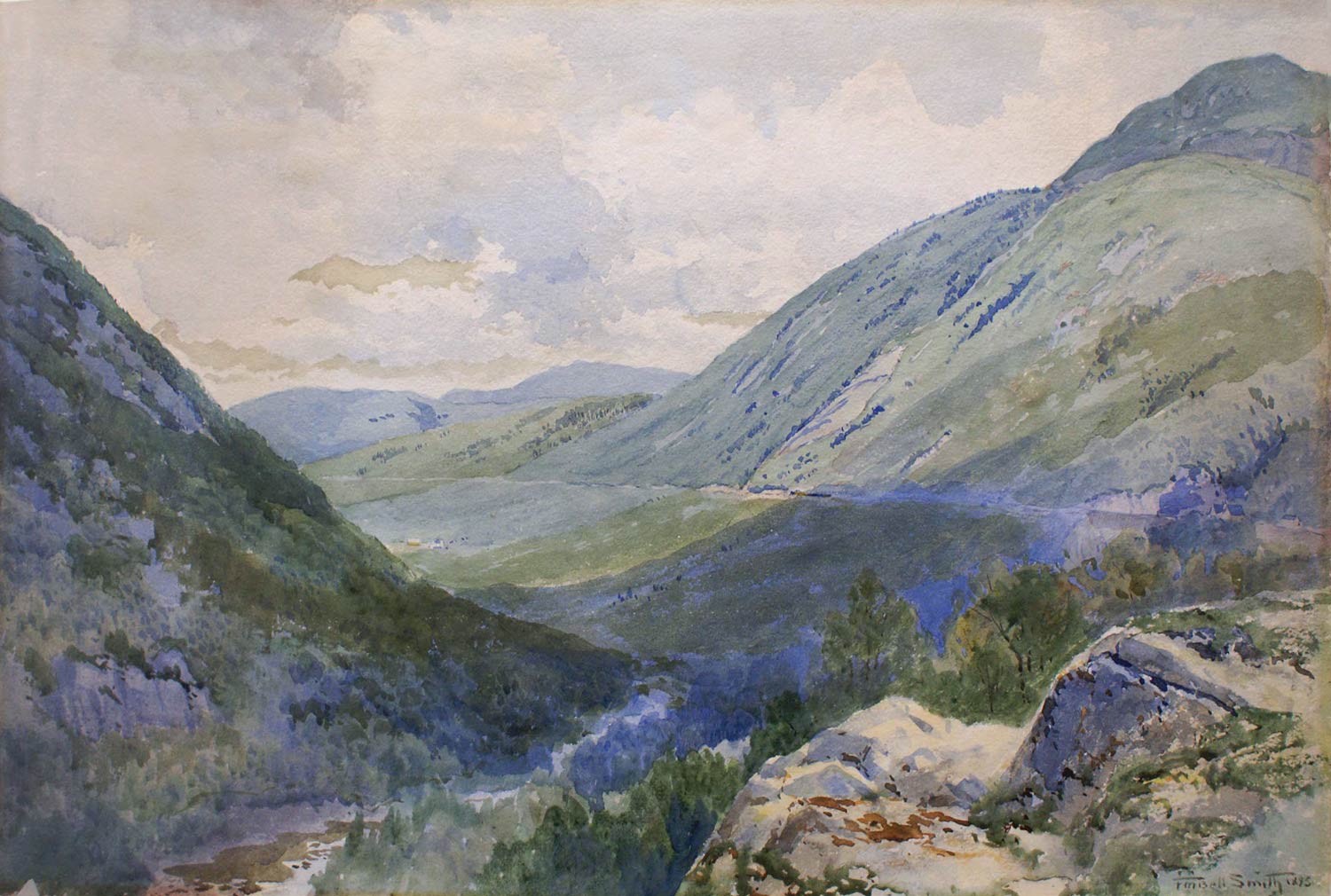Crawford Notch, White Mountains, New Hampshire — By Frederic Marlett Bell-Smith 19th century watercolor
Courtesy of the White Mountain Art & Artists
 A little more than a century ago, a handful both fledgling and experienced artists trekked to the mountain peaks of New Hampshire’s White Mountains with their paints and canvas to capture some of the most stunning views in New England. The result is a collection of work that was inspired by the landscape and served to inspire others to protect it. In many cases, that natural scenery looks substantially different today. The Appalachian Trail Conservancy’s (ATC) Visual Resource Inventory tries to capture that change and, in some cases, protect the views that have become iconic along the A.T. Many understand scenery as something we connect to on a visceral level, and that this connection is so instinctual that it precludes quantification and categorization. What we know (and landscape architects around the world would agree) is that there is a certain science to appealing scenery. We can capture it in words, and art, and in some regards, quantify it too. For the first time, the ATC is putting significant resources behind an effort called the Visual Resource Inventory. Through this process, we frame visual resources as one of the many natural resources of the A.T.
A little more than a century ago, a handful both fledgling and experienced artists trekked to the mountain peaks of New Hampshire’s White Mountains with their paints and canvas to capture some of the most stunning views in New England. The result is a collection of work that was inspired by the landscape and served to inspire others to protect it. In many cases, that natural scenery looks substantially different today. The Appalachian Trail Conservancy’s (ATC) Visual Resource Inventory tries to capture that change and, in some cases, protect the views that have become iconic along the A.T. Many understand scenery as something we connect to on a visceral level, and that this connection is so instinctual that it precludes quantification and categorization. What we know (and landscape architects around the world would agree) is that there is a certain science to appealing scenery. We can capture it in words, and art, and in some regards, quantify it too. For the first time, the ATC is putting significant resources behind an effort called the Visual Resource Inventory. Through this process, we frame visual resources as one of the many natural resources of the A.T.
So many of us are inspired by what we consider “pristine” landscapes. However, not all views derive their worth from being unspoiled by human change and development. Using categories developed by the National Park Service in their “Enjoy the View” process, each view should be taken within the context of its specific setting. While many of us cherish those entirely natural views, we can also acknowledge that there are a host of other beautiful scenes along the A.T., including rolling farmland in Pennsylvania and quaint townscapes in New England.
When looking at a view, we do not see the invisible boundary lines between land parcels. Therefore, much of what we see when looking out from the Trail is beyond the protected corridor. A forested view we have now may not remain that way if the forest is privately held land with no conservation protections. Increased residential and energy development in the congested Appalachian corridor threaten some of the views visitors most cherish. To evaluate and potentially mitigate these threats, a robust dataset documenting the resource — in this case scenery — will be needed. The ETV process is how we are building this baseline dataset.
The effort to document all Trail views is beginning this year. The project is currently funded through 2022 and will capture all views in Pennsylvania and New Jersey. While each view along the Trail may differ in scope and composition, all of them are important to preserving the irreplaceable A.T. experience, and all of them inspire us for a wide variety of reasons.

 A little more than a century ago, a handful both fledgling and experienced artists trekked to the mountain peaks of New Hampshire’s White Mountains with their paints and canvas to capture some of the most stunning views in New England. The result is a collection of work that was inspired by the landscape and served to inspire others to protect it. In many cases, that natural scenery looks substantially different today. The Appalachian Trail Conservancy’s (ATC) Visual Resource Inventory tries to capture that change and, in some cases, protect the views that have become iconic along the A.T. Many understand scenery as something we connect to on a visceral level, and that this connection is so instinctual that it precludes quantification and categorization. What we know (and landscape architects around the world would agree) is that there is a certain science to appealing scenery. We can capture it in words, and art, and in some regards, quantify it too. For the first time, the ATC is putting significant resources behind an effort called the Visual Resource Inventory. Through this process, we frame visual resources as one of the many natural resources of the A.T.
A little more than a century ago, a handful both fledgling and experienced artists trekked to the mountain peaks of New Hampshire’s White Mountains with their paints and canvas to capture some of the most stunning views in New England. The result is a collection of work that was inspired by the landscape and served to inspire others to protect it. In many cases, that natural scenery looks substantially different today. The Appalachian Trail Conservancy’s (ATC) Visual Resource Inventory tries to capture that change and, in some cases, protect the views that have become iconic along the A.T. Many understand scenery as something we connect to on a visceral level, and that this connection is so instinctual that it precludes quantification and categorization. What we know (and landscape architects around the world would agree) is that there is a certain science to appealing scenery. We can capture it in words, and art, and in some regards, quantify it too. For the first time, the ATC is putting significant resources behind an effort called the Visual Resource Inventory. Through this process, we frame visual resources as one of the many natural resources of the A.T.
So many of us are inspired by what we consider “pristine” landscapes. However, not all views derive their worth from being unspoiled by human change and development. Using categories developed by the National Park Service in their “Enjoy the View” process, each view should be taken within the context of its specific setting. While many of us cherish those entirely natural views, we can also acknowledge that there are a host of other beautiful scenes along the A.T., including rolling farmland in Pennsylvania and quaint townscapes in New England.
The Enjoy the View (ETV) process is a two-part system. First, field teams travel along the Trail to describe the landscape and assess its scenic quality. Second, multi-disciplinary teams describe the designations of that landscape and assess its relative importance. These two pieces together create a Scenic Inventory Value, which rates views on a scale from “very high” to “very low.” The process is designed to be objective and replicable; and while team composition for each piece will vary over time, following consistent guidelines and using a rubric keeps things sound. The ETV process also engages a wide variety of stakeholders.
When looking at a view, we do not see the invisible boundary lines between land parcels. Therefore, much of what we see when looking out from the Trail is beyond the protected corridor. A forested view we have now may not remain that way if the forest is privately held land with no conservation protections. Increased residential and energy development in the congested Appalachian corridor threaten some of the views visitors most cherish. To evaluate and potentially mitigate these threats, a robust dataset documenting the resource — in this case scenery — will be needed. The ETV process is how we are building this baseline dataset.
The effort to document all Trail views is beginning this year. The project is currently funded through 2022 and will capture all views in Pennsylvania and New Jersey. While each view along the Trail may differ in scope and composition, all of them are important to preserving the irreplaceable A.T. experience, and all of them inspire us for a wide variety of reasons.